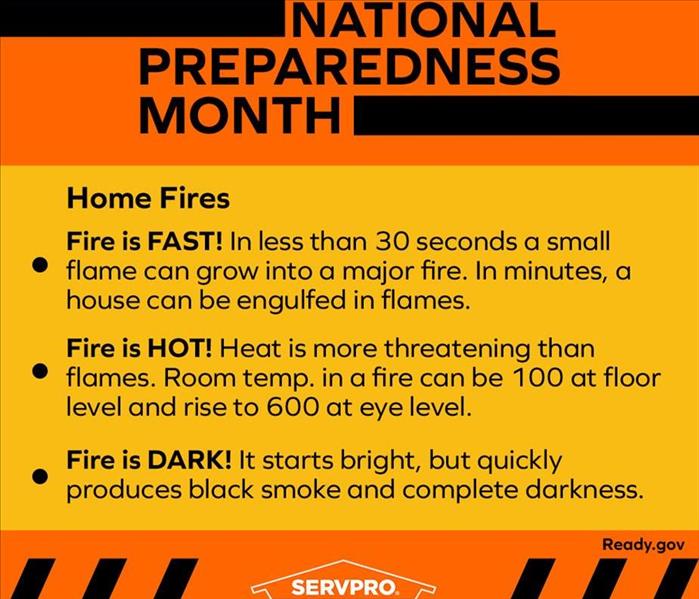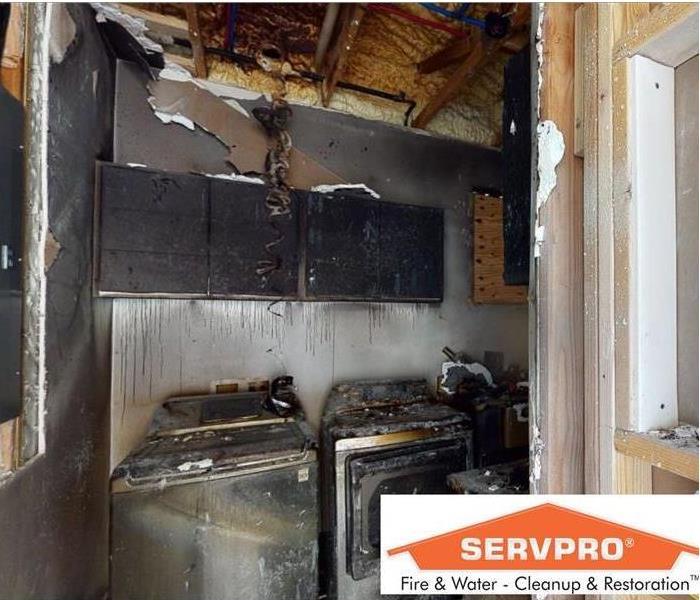Recent Posts
The Different Types of Fire Damage
6/20/2024 (Permalink)
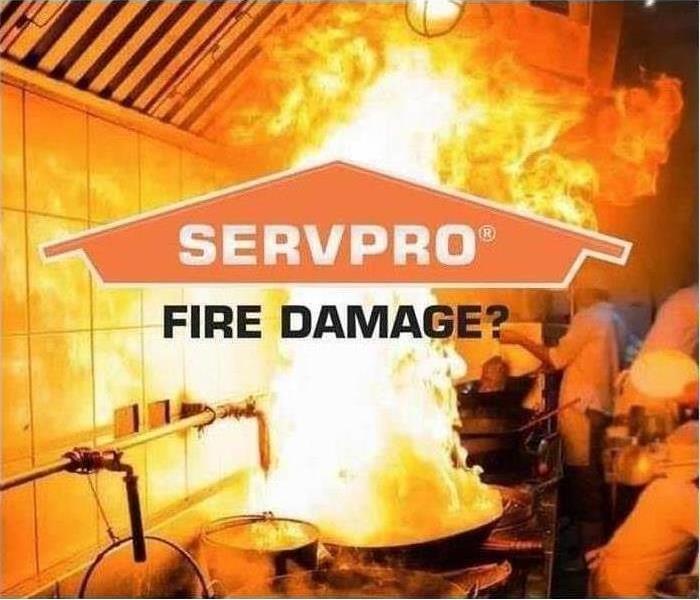 Kitchen on fire with SERVPRO logo above it.
Kitchen on fire with SERVPRO logo above it.
Dealing with fire damage can be a long process. The fire could have been small, but its smoke did most of the damage. Conversely, most of the damage could have been from the fire itself. Lastly, another layer of damage could have been caused when the fire was extinguished. Here are the main types of fire damage that are commonly dealt with.
Flame Damage—This could be from an electrical outlet that caused damage that led to a full-blown kitchen fire.
Smoke Damage—Smoke is literally in the air and can (and will) get into everything. Even after the rebuild is completed, the property can still have a lingering smell of smoke unless it is dealt with correctly.
3rd Party Damage - This type of damage comes from any in-house sprinkler system used to put the fire out or from the Fire Department themselves when they get to the scene.
Heat Damage—Even though a part of the structure might not have actually caught fire, it was probably severely heated. This can cause structural damage and possible swelling that you might overlook right away.
After a fire, you could simultaneously deal with flame, smoke, water, and heat damage. FEMA has some great information on what to do after the fire. The best way to ensure this is taken care of promptly and properly is to contact the team at SERVPRO to get on the job!
Preventing Mold in your Home or Office closet.
6/20/2024 (Permalink)
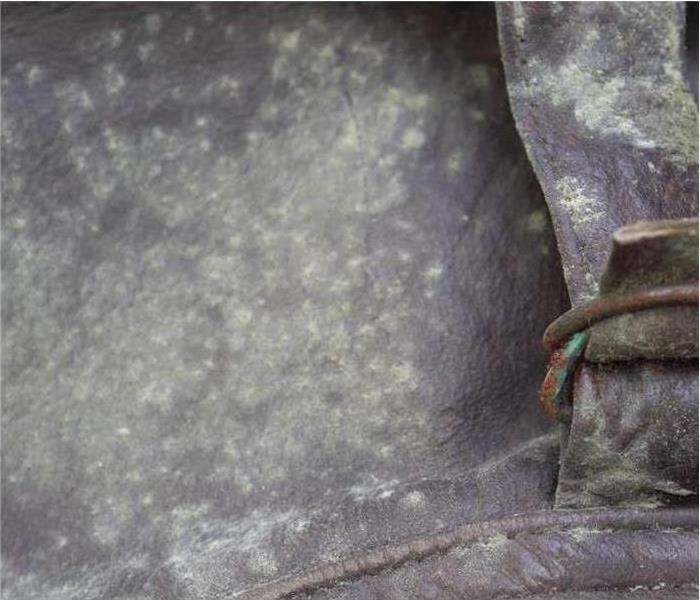 This is what can happen to your wall when moisture and mold go unchecked.
This is what can happen to your wall when moisture and mold go unchecked.
Mold can grow anywhere in homes, including closets. Here are some tips to keep your closets dry and mold-free!
- Make sure that clothes are completely dry before storing them in closets. The moisture in clothing can accelerate mold growth.
- Store only clean clothing and items in closets as dirt and other organic substances are potential food sources for mold.
- Don’t pack clothes or other items too tightly in closets. Allow air to circulate between them to reduce moisture.
- Don’t store items on the closet floor to prevent trapping moisture underneath them.
- Leave closets open when possible. Replace solid closet doors curtains for better airflow.
- Avoid opening closets if they are in rooms with high humidity, particularly when producing moisture (e.g., showering or cooking).
- If you have a humidity problem in your home, use the air conditioning unit or a dehumidifier to remove excess moisture from the air.
- If clothes in a closet smell musty, take them out and fix the moisture problem.
What to do if your apartment becomes flooded!
6/20/2024 (Permalink)
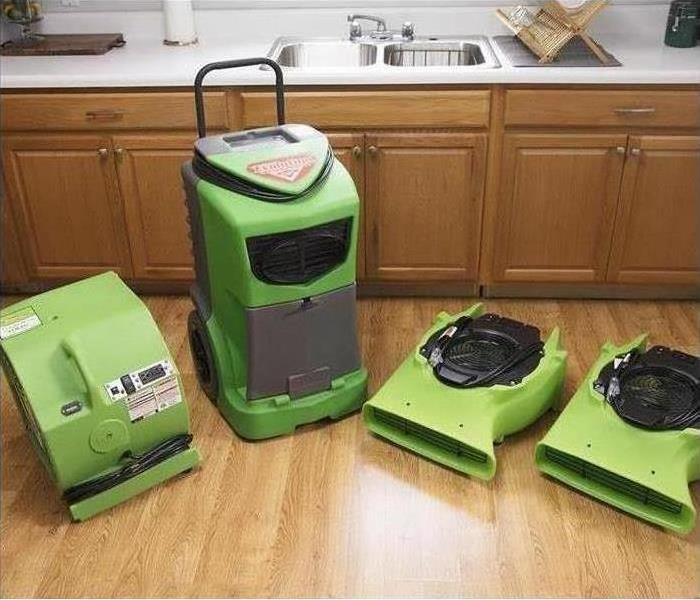 SERVPRO equipment is on the job site and ready to start the water remediation process.
SERVPRO equipment is on the job site and ready to start the water remediation process.
SERVPRO of Tate, Tunica & Southwest DeSoto Counties highlights the steps to water removal from an apartment.
Being in a flooded apartment is an awful experience. The water can damage your belongings and put you out of your home for days. A flooded flat has numerous effects, ranging from mold growth to wet carpets and broken furnishings.
As a homeowner or renter, you must act fast when faced with water damage to limit the level of damage. The starting point is to get all the water out of the building.
The water restoration specialists at SERVPRO of Tate, Tunica & Southwest DeSoto Counties, a leading water removal company in Mississippi, have outlined the following tips for water removal in a flooded apartment.
1. Identify the cause of the flooding
Floods vary greatly from one another. Flooding from ruptured frozen pipes differs from flooding caused by a sewage backup. Identifying the cause of the flooding will increase the chances of quickly solving the issue.
Let's say the flooding in your residence results from a blocked and overflowing toilet. You may close the water valve supplying the toilet to prevent the flooding from getting worse.
2. Pump out the water
A pump can be helpful if you have standing water several inches deep. But, it’s important to pump slowly, as pumping water out too quickly could undermine the property’s foundations.
Sump pumps can be rented for approximately $50 per day or bought for $100 and higher. However, it’s always best to engage a water damage restoration expert, as they have the required tools, including industrial water pumps.
3. Use a bucket
Another way to get water from your property if you don’t have a pump is with a bucket. It’s very straightforward: pack the water in the bucket and pour it outside or inside a larger container, which you’ll discharge outside.
While this is economical, removing water with a bucket can be very stressful and time-consuming.
4. Contact your neighbors
Notifying your neighbors of the flood in your apartment is polite, especially if you have downstairs neighbors.
Depending on the extent of the flooding, the water can easily flow into their flat from the ceiling. Giving them advance notice will prevent that unpleasant surprise and allow them time to take preventative measures.
5. Speak with your landlord
The next step is to contact your landlord if you rent rather than own your unit. You should inform your landlord as soon as possible about the problem because they are in charge of preventing damage to the property, including water damage.
6. Secure your belongings
If your apartment is flooded, you most likely won't be able to shield all of your belongings from water damage. It would be best to relocate anything from the flooded area to prevent massive damage. The items can be kept in a room far from the flooded area or placed high enough so the water won't reach them.
Grab as many belongings as possible if you must evacuate your house due to flooding.
7. Speak with your insurance provider
Renters' insurance is a must if you rent a place. While the expense of fixing the structure is your landlord's responsibility, the loss of your personal property is probably covered by your renter's insurance policy.
However, remember that damage from some types of flooding is typically not covered by renters' insurance. For instance, unless you have a particular flood rider, your renters' insurance usually won't cover the damage if your apartment floods during a hurricane.
Get professional water removal services in Mississippi.
You can rely on SERVPRO of Tate, Tunica & Southwest DeSoto Counties to handle water removal in your apartment. Their team of certified water damage technicians is trained to clean up water damage as quickly and effectively as possible. They will arrive at your home with state-of-the-art tools to clean, dry, and restore the apartment and belongings to their preloss state.
Are you ready to get started? Call SERVPRO ofT ate, Tunica & Southwest DeSoto Counties today!
What to do when you return home after storm damage has occurred.
6/20/2024 (Permalink)
 FEMA suggests 4 things that you should do after returning home from a flood occurrence.
FEMA suggests 4 things that you should do after returning home from a flood occurrence.
When storms send floodwater into your home, you don't always know what to do. When is it safe to return to your house? Can you start the cleanup on your own? How you handle a flood will depend on the severity of the damage. It can be helpful to call about storm damage services right after the storm has left your area. It would be best if you also tried to avoid doing the following:
1. Walking Into Standing Water
Did you know that 6 inches of moving water can cause you to lose footing? Because even shallow waters can be dangerous, you should avoid walking into standing water. Your flooded home may be full of stagnant water, but you should avoid entering it. If the electricity is on, the water could be charged. Stormwater could contain dangerous contaminants, too.
2. Waiting To Schedule a Cleanup
Do you want to try to tackle the water damage on your own? Unless you know how to remove flooding and humidity from your house effectively, you should turn to a professional. The sooner you can schedule your cleanup, the better it will be for your home. If you wait too long, you may have increased mold growth in your space.
3. Returning to Your Home Too Soon
While you want your life to return to normal, you must ensure the flood water is completely gone before you return. Going home too soon can make it harder for the cleanup crew to remove excess humidity properly. The cleanup may require replacing building materials, which can leave your home dusty. If you wait until the entire process is finished, you can return to a more normal life right when you move back in.
Storm flood water may cause you to leave your home until the damage can be fixed. Taking the wrong steps after this type of flood can make the restoration process harder than it has to be, so remember what not to do. You can find more detailed information from Ready.gov.
Why SERVPRO of Olive Branch & Marshall County
5/1/2023 (Permalink)
Your local SERVPRO in Olive Branch & Marshall County is ready for any size job that comes our way. Did you receive water damage to your home, office, or even warehouse? No problem! We have the equipment (and enough of it) to handle whatever job you need us for. Once we arrive on the scene we will quickly assess the situation and decide where to start and what to use. We have a warehouse full of equipment, but some of the most common types that we use are listed below.
Detection Equipment - we have sensors that help us locate where the water could be hiding and other sensors that constantly monitor the moisture in the surrounding areas.
Extraction Equipment - these tools are used to start removing the liquid. Think of everything from a wet/dry vacuum, all the way to one that hooks up to one of our trucks on site. Yeah….it sucks.
Air Movers - we use multiple-sized air movers (we won’t get upset if you call them fans) to start circulating the air and removing the remaining moisture.
SERVPRO of Olive Branch & Marshall County will be here for you, no matter how big the job is. If water damage should happen to your property in the future, don’t hesitate (you don’t want the water sitting there either) to call the team at SERVPRO!
Tips On How To Prevent Home/Office Fires
5/1/2023 (Permalink)
Nobody wants to think about their home or office catching on fire. Sometimes these things happen and they are totally out of our control, but there are a lot of things that we can do to help prevent them.
FEMA’s records show that just over half (50.2%) of residential fires are caused by cooking-related accidents. The next three biggest reasons are Heating (9.3%), Electrical Malfunction (6.8%), and Intentional (4.5%).
Here are a few things that you can do to help prevent a house fire and protect your family.
Pay attention when cooking. If you need to step out of the room, ask someone to watch the food until you get back, or turn off the stove and stop cooking.
Test your smoke alarms regularly.
Check the dryers’ airflow. Pull the lint trap and clean it every time you dry a load of clothes.
Be careful with power cords and strips. Attaching too many appliances to one power strip can draw more power than the cord is able to handle. This can cause it to heat up and potentially catch on fire.
Store flammable products away from heat sources.
Place fire extinguishers in key locations around your house. Make sure that everyone in the home knows how to properly use them.
If you need help after a fire, SERVPRO of Olive Branch & Marshall County is here to help. We can replace the damaged areas, check your electrical system for any potential issues, and can even help you get that smoke smell out of your home.
FEMA, https://www.usfa.fema.gov/data/statistics/#causesR
SERVPRO Commercial Services
5/1/2023 (Permalink)
SERVPRO of Olive Branch & Marshall County offers office disinfection services that are a step above cleaning with household chemicals. The Center for Disease Control suggests hospital-grade cleaners that are able to kill certain bacteria. It is extremely important to target the high-touch and high-traffic areas of your business.
The EPA defines the differences between Cleaning, Sanitizing, and Disinfection as follows:
Cleaning - removes dirt and organic matter from surfaces using soap or detergents.
Sanitizing - kills bacteria on surfaces using chemicals. It is not intended to kill viruses.
Disinfecting - kills viruses and bacteria on surfaces using chemicals.
Some of the most common places that need extra attention at your business are handles, keyboards, public tables, faucets, light switches, phones, desks, and probably everything in the break room.
Feel free to call SERVPRO of Olive Branch & Marshall County to set up a consultation on helping keep your office environment at its best.
EPA link - https://www.epa.gov/coronavirus/what's-difference-between-products-disinfect-sanitize-and-clean-surfaces
CDC link - https://www.cdc.gov/
Dryer Lint Fire Prevention
5/1/2023 (Permalink)
While it is easy to forget to clear dryer lint between loads of laundry, this small oversight can have severe consequences. In fact, according to the U.S. Fire Administration, there are approximately 2,900 dryer-related fires each year, accounting for $35 million in property loss, five deaths, and 100 injuries. Additional facts include:
- 34% of people regularly fail to clean their dryers, making it the leading cause of home clothes dryer fires
- Dryer fires occur most prominently in the fall and winter, spiking in January
Keeping an eye on your dryer lint is an easy way to prevent fire damage to your home or business and keep yourself safe. This article outlines the ways dryer lint can pose a fire threat, how to safely ensure your dryer lint is regularly disposed of, and how SERVPRO® can help if your dryer catches on fire.
What is Dryer Lint?
According to Merriam-Webster Dictionary, lint is defined as “Fuzz consisting especially of fine ravelings and short fibers of yarn and fabric.” In other words, it is the material that comes off clothing, towels, and other cloth during the drying process. If not regularly emptied between loads, your lint trap could become stuffed with lint to the point of being a hazard. Combined with the friction and heat of a dryer, fires could be triggered during routine laundry duties.
Dryer Vent vs. Lint Trap
Before we get into precautionary tips, it is important to outline the difference between two commonly confused parts of a dryer: a dryer vent, and a lint trap. So, what’s the difference?
This resource on Whirlpool’s website outlines the internal and external parts of a dryer. According to Whirlpool, a lint trap is “located either on the exterior of the dryer or the inside door opening. It collects lint and debris as it passes through the dryer vent.”
Allwords defines a dryer vent as “A vent connected to a clothes dryer that is used to screen lint and remove exhaust.”
Dryer Lint Fire Prevention Tips
According to the U.S. Fire Administration, the following tips can help prevent dryer lint and other laundry-related fires:
- Every three months, clean lint out of the vent pipe
- Clean behind the dryer where lint can build up
- Use a nylon brush to clean the lint filter every six months (or more often) to prevent clogging
- Have a professional regularly inspect and clean your dryer, especially when it is taking longer than normal to dry
- Unplug or disconnect the dryer if you will be away for an extended period
- Ensure the area surrounding the dryer is free of materials that may catch fire
Furthermore, there are two things you shouldn’t do:
- Do not use a lint filter that is clogged, damaged, or loose
- Do not use a dryer without a lint filter
Ultimately, one of the easiest tips to remember (mentioned at the beginning of this article) bears repeating—clean out your lint trap between each load of laundry, and you will substantially reduce the chance of fire.
Storm Season doesn't end when Hurricane season does.
5/1/2023 (Permalink)

Even though storm season is wrapping up rather quickly, a nearby road overflow can cause significant issues in the ground levels of your property. Heavy rainfall results in sewer systems backing up and overflowing with contaminated Black Water. Due to the potentially harmful effects of Black Water, it is essential to hire a professional, qualified technician to help repair and restore your property safely. Indeed, many of your possessions can be salvaged by using professional cleaning equipment promptly.
Where there is Flood Damage in SERVPRO® of Olive Branch & Marshall County homes, the likelihood of contaminants being spread around the home is high. In the circumstances, it is not uncommon for our technicians to wear Hazmat suits to protect themselves from pathogens during the cleanup operation. We may also have to remove sections of drywall to clean in and behind walls, floors, and fittings. Left behind debris is not only odorous but has the potential to be harmful if not dealt with thoroughly.
For owners who find themselves in this position, it is only natural to immediately assume the worst, especially where personal possessions are concerned. Here at SERVPRO®ofOlive Branch & Marshall County, we always work with a restore over replace mentality. Unlike other providers, our services are geared toward salvaging as much as possible. We enable our technicians to achieve this by providing them with state-of-the-art cleaning equipment and technology.
We can assess items immediately on-site to decide which possessions are salvageable and which need disposal. Generally speaking, porous materials absorb black water making them exceptionally difficult to clean; this could include your carpets or curtains. However, where they are valuable fabrics, we can send them to a specialized facility for mechanical cleaning using Esporta washing machines. This equipment is expensive because they are advanced. However, SERVPROOlive Branch & Marshall County provides technicians with everything they need to restore items rather than replace them.
Floods are considerable emergencies which is why SERVPRO training involves a rapid-response unit as well as a 24-hour emergency call line. Our skilled specialists are local to the area and can reach you fast to help mitigate loss and reduce the risk of permanent damage.
In an emergency, contact the SERVPRO professionals right away!

 24/7 Emergency Service
24/7 Emergency Service





